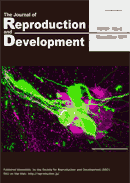Volume 56, Issue 2
April
Displaying 1-18 of 18 articles from this issue
- |<
- <
- 1
- >
- >|
Original Article
-
Article type: -Original Article-
2010 Volume 56 Issue 2 Pages 187-190
Published: 2010
Released on J-STAGE: May 11, 2010
Advance online publication: February 05, 2010Download PDF (168K) -
Article type: -Original Article-
2010 Volume 56 Issue 2 Pages 191-194
Published: 2010
Released on J-STAGE: May 11, 2010
Advance online publication: December 25, 2009Download PDF (259K) -
Article type: -Original Article-
2010 Volume 56 Issue 2 Pages 195-199
Published: 2010
Released on J-STAGE: May 11, 2010
Advance online publication: December 25, 2009Download PDF (205K) -
Article type: -Original Article-
2010 Volume 56 Issue 2 Pages 200-207
Published: 2010
Released on J-STAGE: May 11, 2010
Advance online publication: December 25, 2009Download PDF (364K) -
Article type: -Original Article-
2010 Volume 56 Issue 2 Pages 208-211
Published: 2010
Released on J-STAGE: May 11, 2010
Advance online publication: December 25, 2009Download PDF (81K) -
Article type: -Original Article-
2010 Volume 56 Issue 2 Pages 212-218
Published: 2010
Released on J-STAGE: May 11, 2010
Advance online publication: December 09, 2009Download PDF (140K) -
Article type: -Original Article-
2010 Volume 56 Issue 2 Pages 219-222
Published: 2010
Released on J-STAGE: May 11, 2010
Advance online publication: December 09, 2009Download PDF (259K) -
Article type: -Original Article-
2010 Volume 56 Issue 2 Pages 223-229
Published: 2010
Released on J-STAGE: May 11, 2010
Advance online publication: December 25, 2009Download PDF (166K) -
Article type: -Original Article-
2010 Volume 56 Issue 2 Pages 230-235
Published: 2010
Released on J-STAGE: May 11, 2010
Advance online publication: December 25, 2009Download PDF (263K) -
Article type: -Original Article-
2010 Volume 56 Issue 2 Pages 236-242
Published: 2010
Released on J-STAGE: May 11, 2010
Advance online publication: December 25, 2009Download PDF (571K) -
Article type: -Original Article-
2010 Volume 56 Issue 2 Pages 243-250
Published: 2010
Released on J-STAGE: May 11, 2010
Advance online publication: December 25, 2009Download PDF (412K) -
Article type: -Original Article-
2010 Volume 56 Issue 2 Pages 251-255
Published: 2010
Released on J-STAGE: May 11, 2010
Advance online publication: January 27, 2010Download PDF (112K) -
Article type: -Original Article-
2010 Volume 56 Issue 2 Pages 256-262
Published: 2010
Released on J-STAGE: May 11, 2010
Advance online publication: January 27, 2010Download PDF (258K) -
Article type: -Original Article-
2010 Volume 56 Issue 2 Pages 263-270
Published: 2010
Released on J-STAGE: May 11, 2010
Advance online publication: January 27, 2010Download PDF (322K) -
Article type: -Original Article-
2010 Volume 56 Issue 2 Pages 271-278
Published: 2010
Released on J-STAGE: May 11, 2010
Advance online publication: January 27, 2010Download PDF (315K)
Technology Report
-
Article type: -Technology Report-
2010 Volume 56 Issue 2 Pages 279-284
Published: 2010
Released on J-STAGE: May 11, 2010
Advance online publication: December 25, 2009Download PDF (144K) -
Article type: -Technology Report-
2010 Volume 56 Issue 2 Pages 285-290
Published: 2010
Released on J-STAGE: May 11, 2010
Advance online publication: January 27, 2010Download PDF (178K) -
Article type: -Technology Report-
2010 Volume 56 Issue 2 Pages 291-296
Published: 2010
Released on J-STAGE: May 11, 2010
Advance online publication: January 27, 2010Download PDF (135K)
- |<
- <
- 1
- >
- >|
